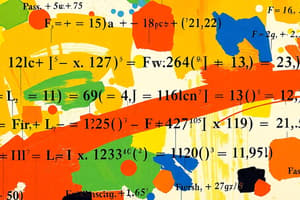Podcast
Questions and Answers
What unit is used to measure density?
What unit is used to measure density?
- grams (g)
- liters (L)
- joules (J)
- grams per cubic centimeter (g/cm³) (correct)
Which formula correctly calculates mass?
Which formula correctly calculates mass?
- D x V (correct)
- I x R
- V / R
- E / T
What does the symbol 'I' represent in electrical terms?
What does the symbol 'I' represent in electrical terms?
- Resistance
- Voltage
- Charge
- Current (correct)
The relationship V = I x R expresses which electrical concept?
The relationship V = I x R expresses which electrical concept?
Which of the following correctly defines resistance?
Which of the following correctly defines resistance?
What unit is voltage measured in?
What unit is voltage measured in?
If substance A has a low density and substance B has a high density, which statement is correct?
If substance A has a low density and substance B has a high density, which statement is correct?
What relationship does the formula E = P x T express?
What relationship does the formula E = P x T express?
Flashcards
Density
Density
A measure of how much matter is packed into a given space. It's calculated by dividing mass by volume.
Volume
Volume
The amount of space an object occupies. It's the three-dimensional extent of an object.
Mass
Mass
The fundamental property of matter. It's a measure of the amount of substance in an object.
Voltage
Voltage
Signup and view all the flashcards
Resistance
Resistance
Signup and view all the flashcards
Current
Current
Signup and view all the flashcards
Conductivity
Conductivity
Signup and view all the flashcards
Neutrons
Neutrons
Signup and view all the flashcards
Study Notes
Physical Quantities and Formulas
- Density (D): Mass of a substance per unit volume. Measured in g/cm³. Formula: m/V (mass/volume)
- Volume (V): Amount of space occupied by a substance. Measured in cm³.
- Mass (m): Quantity of matter in a substance. Measured in grams (g).
- Voltage (V): Electrical potential difference. Measured in Volts (V).
- Resistance (R): Opposition to the flow of electric current. Measured in Ohms (Ω).
- Current (I): Flow of electric charge. Measured in Amperes (A).
- Energy (E): Capacity to do work. Measured in Joules (J).
- Charge (Q): Amount of electric charge. Measured in Coulombs (C).
- Time (t): Duration of an event. Measured in seconds (s).
Factors Affecting Resistance
- Length: Shorter length results in lower resistance; longer length leads to higher resistance.
- Thickness: Thicker material allows electrons to flow easily (lower resistance); thinner material restricts electron flow (higher resistance).
- Temperature: Higher temperature leads to electrons moving faster (higher resistance); lower temperature means slower electron movement (lower resistance).
Studying That Suits You
Use AI to generate personalized quizzes and flashcards to suit your learning preferences.




